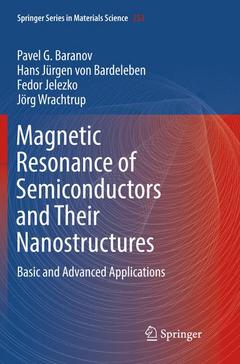Description
Magnetic Resonance of Semiconductors and Their Nanostructures, 1st ed. 2017
Basic and Advanced Applications
Springer Series in Materials Science Series, Vol. 253
Authors: Baranov Pavel G., von Bardeleben Hans Jürgen, Jelezko Fedor, Wrachtrup Jörg
Language: English
Subject for Magnetic Resonance of Semiconductors and Their...:
Approximative price 158.24 €
In Print (Delivery period: 15 days).
Add to cartPublication date: 05-2018
Support: Print on demand
158.24 €
In Print (Delivery period: 15 days).
Add to cartPublication date: 03-2017
524 p. · 15.5x23.5 cm · Paperback
Description
/li>Contents
/li>Biography
/li>Comment
/li>
This book explains different magnetic resonance (MR) techniques and uses different combinations of these techniques to analyze defects in semiconductors and nanostructures. It also introduces novelties such as single defects MR and electron-paramagnetic-resonance-based methods: electron spin echo, electrically detected magnetic resonance, optically detected magnetic resonance and electron-nuclear double resonance ? the designated tools for investigating the structural and spin properties of condensed systems, living matter, nanostructures and nanobiotechnology objects. Further, the authors address problems existing in semiconductor and nanotechnology sciences that can be resolved using MR, and discuss past, current and future applications of MR, with a focus on advances in MR methods.
The book is intended for researchers in MR studies of semiconductors and nanostructures wanting a comprehensive review of what has been done in their own and related fields of study, as well asfuture perspectives.
Preface.- Basic Concepts of Electron Paramagnetic Resonance (EPR).- Fundamentals of EPR Related Methods.- Magnetic Resonance Studies of Intrinsic Defects in Semiconductors.- State-of-Art: High-Frequency EPR, ESE, ENDOR and ODMR in Wide-Band-Gap Semiconductors.- Magnetic Resonance in Semiconductor Micro- and Nanostructures.- Perspectives of Applications of Magnetic Properties of Semiconductor Nanostructures and Single Defects.

